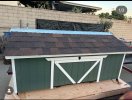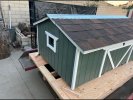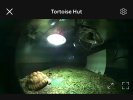So I have a custom built winter enclosure for my torty. It’s been doing great but last night was the first night temps dropped into the low 40s/high 30s and the ceramic bulb couldn’t keep up. The inside temp dropped to 60. During the day he’s getting proper temps, including basking, but when there’s that high of a change he tends to not want to eat the next day or days until it’s more consistent. We learned this when we thought the enclosure would hold the heat overnight and not need the ceramic night temp. Lesson learned. Now I’m trying to figure out if we need a 2nd ceramic bulb (another lamp) or should I do a pig blanket? He’s only a 10lb lil guy, maybe a pound or so more and one always been told heating pads can burn or hurt reptiles?
Images attached of his enclosure. Not seen is the bedding (hay) and two lamps.
Images attached of his enclosure. Not seen is the bedding (hay) and two lamps.



